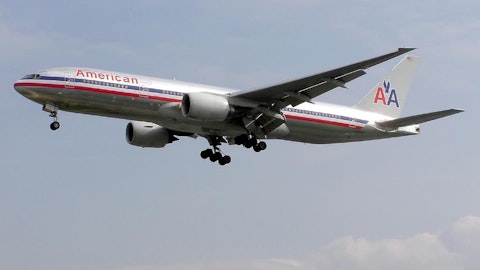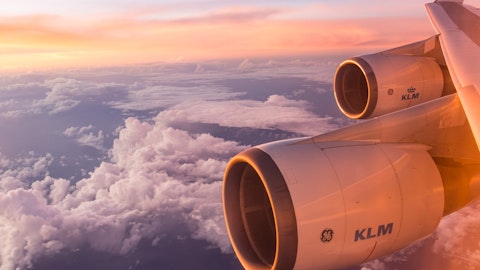Michael O’Leary: And Jason, we’re opening 17 new routes into Savannah and now they knew during in November the winter will be mad?
Jason McGuinness: Yes. So they started last week. They’ve all started very strongly. I’ve been very surprised how quickly all the seats are filling and we’ll certainly be growing in China in summer 2024. Like, I think we would be close to 2 million, 2.5 million passengers in Toronto over the next 12 months. And it’s certainly a base candidate over the next 12 to 18 months, Tarana is trying out for a low-cost carrier, and we’ve seen that in terms of reaction from consumers. But generally, across these winter demand, the strong across CEE, Scandinavia, Italian domestics are very strong. I think that’s helped by what we’ve done on the schedule that you alluded to earlier. 70% of our capacity now for winter 2023 is at the weekend versus 65% last year and 60% prior to COVID. So there’s been a lot of work done by the revenue scheduled team to deliver that and it’s paying dividends across Q3.
Jarrod Castle: Thanks very much.
Michael O’Leary: Thanks.
Operator: The next question comes from Stephen Furlong from Davy. Please go ahead your line is now open.
Stephen Furlong: Good morning, Michael. Yes, two questions, please. Maybe if Thomas is there, you can talk about the, any updates on SaaS and also how the winglets are performing in terms of fuel efficiency. And then kind of in that vein, I just want to ask Neil about, I know it’s the first quarter and Q4 is going to be at the unwinding of the free allowances on ETS. And can you just talk about that and that overall scheme? And obviously you’ve been paying ETS for 10 years, but the freelancers go over the next couple of years, that’d be great. Thank you.
Thomas Fowler: Yes. Stephen, just on the SaaS side, so obviously in recent weeks, we’ve added done some fuel with OMV in Vienna. We’ve picked up some SaaS, so it gives us more access to different feedstocks, and we’re working hard with another one of our field partners to hopefully selling in MOU and with them to increase our target like our percentage target. We’re at 9.5% today with this if we get this MOU over the line, we’ll be above 10% of our staff will be doing through MOUs. On the winglets, we’ve been happy with what’s installed today. We’re seeing close to the 1.5% savings that we disclosed on the winglet side. So yes, it’s going well and we hope to roll out another 100 over the winter to get to 130 by the end of the maintenance season this year.
So we’ll see more of an impact come true with more on the Margaux on the aircraft. On the ETS side Steven. So yes, as you said, the allowance to start rolling off in Q4, which is an impact. So like we have about 25% of our allowances compared to Q4 last year will be gone under ETS. This quarter which will impact on Q4 profitability and also our hedge rate has gone up from about to quarter on quarter compared to FY 2023 and FY 2024 which will have which is the impact Neil and Michael have been talking about in ETS in Q4.
Michael O’Leary: But I would add into that too, like you also have three ETS allowances even unwinding for the legacy guys who have far more of their free their traffic covered by the free ETS. So I think again that’s one reason why we’re seeing some aggressive pricing from the legacy shortfall across Europe and can save market base driving up the headline fare, particularly in countries like Germany, where Lufthansa has a near monopoly, Air France, KLM, same in the Holland and in France. And I think that’s driving up our airfares, the extent which competitors are dramatically increasing their airfares. Next question please.
Operator: The next question comes from Dudley Shanley from Goodbody. Please go ahead. Your line is now open.
Dudley Shanley: Thank you. Good morning, everyone. If I could ask two slightly longer-term questions, first of all, if we think about the problem with the GTF issue coming on top of the delivery delays from Airbus and Boeing, how do you see that playing out in terms of the outlook for fares over the medium term? And then switching to consolidation in Europe, which seems have picked up recently. Obviously, there’s a lot of deals going on. Which deals do you think will happen? How do you see the end game here? How does Ryanair position to take advantage of it?
Michael O’Leary: Let me see. We’ll add that to instead of me, I mean, medium term affairs Eddie and Jason McGuinness might add on to that and then I’ll come back in on the consolidation. So Eddie, Jason on medium term fares.
Edward Wilson: We have seen already that we’ve guided sort of our mid-teens in terms of Q3. But I think a lot of what’s going to happen at a micro level with the GTS issue is going to be where some of our competitors where our competitors are going to allocate that share, going to allocate that capacity in particular markets. And we’ve seen a lot of them announcements of base aircraft that just don’t add up to the total fleet. With some of our competitors, we’ve seen a retreat in places like in the Italian domestics which Jason has said like where fares are actually becoming more robust. I wouldn’t like to sort of call it as a sort of a macro level where fares are going to go to, but certainly at a micro level, it’s going to be where that capacity is allocated with our competitors, but with reduced capacity and no new aircraft coming online from the OEMs I think we’re still going to see — I think we’re going to see like fares continuing to rise against that backdrop where economies continue to grow.
And there isn’t any capacity there to match it. So I think fares still in the like certainly over the next 12 months, we’re going to continue to rise, Michael.
Michael O’Leary: Jason?
Jason McGuinness: Jason here. I think the — sorry, I just didn’t hear you there, Michael.
Michael O’Leary: Give you a certain chance to have a fair, so I don’t think that’s a general trend over the next couple of years or two or three years.
Jason McGuinness: So I think the general trend is upwards over the next number of years and that’s entirely based on the capacity environment. Like, if you look at this summer, the mark was recovered to 94%, 95%, but that includes Ryanair growth. Without Ryanair growth the market this summer is only recovered to 90%. And I think the market isn’t going to recover our competitors that is much above 90% into S24 S35 for the issues we’ve outlined. So that leaves a market that hasn’t grown for the last four years. And I think you’re seeing that across certain countries, be it Austria, Germany, Belgium, which are all significantly below where they were prior to COVID. And that’s all helping the pricing environment at the moment. And it is — in terms of our growth then, we are growing. We are growing in the likes of Italy, UK and Spain, which is delivering solid fares. And I think they’ll be solid over the next number of years.
Dudley Shanley: Okay. Thanks for that. In terms of consolidation, I have long believed Europe is moving reasonably towards four large carriers. If you look at what’s going on at the moment Lufthansa Air France KLM and AET all are interested, I think longer term, it probably belongs to better in IAG. Because of the Latin American government carried, Latin American kind of influence of IAG, but Portuguese are always wary of the Spanish that they’re somehow closed the EAP base and moved to Madrid. I think if you look at what IAG has done with Aer Lingus, they’ve demonstrated they can continue to grow Transatlantic business to Heathrow and Dublin and did it successfully. SAS is a croc but I expect to get probably stuck together with Norwegian and you’ve got a bigger croc up in the Scandinavia and Air France Canada, they going to take a 20% stake in that refinancing?



